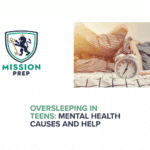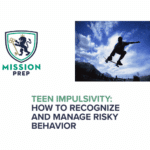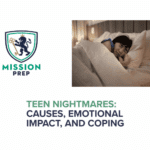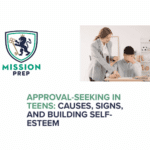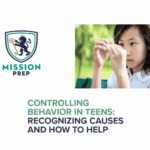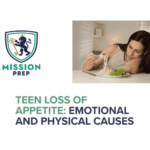Teen Panic Attacks: Symptoms, Triggers, and How to Respond

But have you ever felt completely overwhelmed by a sudden wave of intense fear when there was no obvious cause? If the answer is yes, then you may have experienced a panic attack. Panic attacks are common among teens,1 and they tend to be extremely unpleasant. It can feel like you’re completely losing control or having a heart attack.
In this article, we will cover:
Symptoms of panic attacks- Underlying anxiety disorders associated with panic attacks
- Effective, science-based therapy for teen panic attacks
- Coping strategies for panic attacks
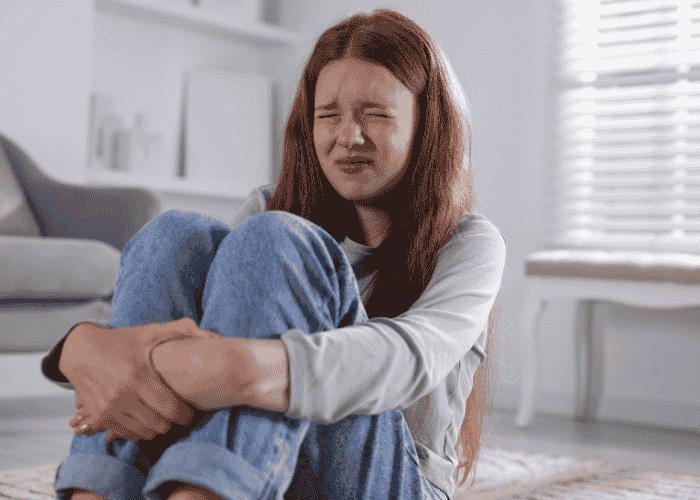
What Are Panic Attacks in Teens?
A racing heart- Sweating
- Trembling/shaking
- Shortness of breath
- Chest pain
- Nausea or stomach discomfort
- Feeling dizzy or faint
- Feeling detached from your body
- Fear that you’re losing control, dying, or losing your mind
Studies show that teen panic attacks are common.1 Anyone can experience them, and if you have a single panic attack, it does not necessarily mean that you have a mental health disorder. However, recurring panic attacks that cause you so much distress that they change your lifestyle may be a sign of “panic disorder”3, which is a mental health problem that affects 1-3% of adolescents.5
Signs of Underlying Anxiety Disorders
If you have a single panic attack, it does not necessarily mean that you have a mental health problem. However, panic attacks do sometimes signal an underlying anxiety disorder.
Anxiety is the most common mental health disorder.4 Studies show that it affects approximately one in four adolescents.5 While there are many specific types of anxiety disorders, panic attacks are particularly linked to:
People with an anxiety disorder routinely experience more intense worry or dread than a particular situation merits.6 The dread and apprehension are persistent and often significantly impact daily life.6
Risk Factors and Causes of Panic in Teens
Research shows that adolescents are especially vulnerable to mental health problems such as anxiety and panic due to the mental, physical, emotional, and social changes they experience at this critical stage in life.7
Common stress triggers in adolescence can include increased academic demands, pressure and worry about the future, social pressures, and maladaptive behaviors such as excessive screen time or inadequate sleep.7 “Major life stress” and “major changes” are considered to be two common causes of panic in teens.7 Other risk factors include:8
- Having a family member who experiences panic attacks or has panic disorder
- Experiencing a traumatic event
- History of abuse
- Smoking
- Excessive caffeine use
Treatments for Managing Anxiety in Teenagers
Treatment for anxiety in teens may include:
Evidence-based therapy, such as cognitive behavioral therapy (CBT) or dialectical behavioral therapy (DBT)- Medications, such as antidepressants
- A combination of therapy and medications
Therapy for Teen Panic Attacks
One of the most effective and well-researched types of therapy for anxiety disorders is called cognitive behavioral therapy (CBT). It is so effective that it is frequently called “the gold standard” treatment for anxiety. Some studies have shown that 60% of adolescents recover from anxiety after receiving CBT.10
Extensive research has also demonstrated that cognitive behavioral therapy can successfully treat panic attacks and panic disorder in teens.11 Through CBT, teens can learn to notice and challenge negative thoughts and beliefs that may contribute to mental health challenges.
Dialectical behavioral therapy (DBT) is another form of evidence-based therapy that has been supported by research for reducing anxiety symptoms in teens.12 DBT emphasizes the development of skills such as distress tolerance and adolescent emotional regulation.
Coping Strategies for Panic
In therapy, you may develop helpful coping strategies for managing and preventing symptoms of panic. Through CBT, for example, you might learn new ways of thinking and reacting to the sensations you feel just before or during a panic attack. This new way of thinking about your symptoms can ultimately help you have fewer panic attacks.3
While it cannot replace professional treatment, prioritizing healthy habits may reduce the effects of panic. You can try prioritizing some of these healthy habits:
Get enough sleep (eight to ten hours per night for teens)13- Stay hydrated
- Eat a healthy diet
- Exercise regularly
- Spend time with supportive people you trust
Relaxation Techniques for Teens
Are you eager to take matters into your own hands and improve your anxiety right away? Relaxation techniques are a highly effective way for teens to reduce stress and anxiety.14 They’re also often extremely convenient. You can experiment with different methods to find what works best for you.
Here are a few relaxation techniques for teens that you can try:
1. Box Breathing
This is a type of breathwork aimed at reducing stress and anxiety.15
For this technique, it can be helpful to imagine that you are slowly tracing a square or box shape. Follow these steps:
As you slowly draw one side of the box, take a long, slow inhale- Without pausing, slowly exhale and draw the next side of the box
- Without pausing, inhale slowly as you draw the third side of the box
- Without pausing, exhale slowly as you draw the fourth side of the box
- Repeat this process for at least five minutes
2. Cyclic Sighing16
Sit or lie down in a comfortable position.- Take a slow, deep inhale through your nose.
- Without exhaling, as soon as your lungs feel fully expanded, try to inhale through your nose again. This second inhale may be smaller, and that’s okay. Taking these two inhalations helps fill the lungs to their maximum capacity.
- Now slowly and completely exhale through your mouth.
- Repeat this process for five minutes.
- Return to normal breathing.
3. Progressive Muscle Relaxation7
Lie down in a comfortable position.- Tighten the muscles in your toes and feet for one or two seconds.
- Next, relax those muscles completely and allow your feet to sink onto the bed or floor beneath you. Notice the muscles feeling totally relaxed.
- Next, tighten the muscles in your calves.
- Then relax the calf muscles completely. Notice them becoming totally relaxed and heavy.
- Continue in this way, tightening a muscle group, then relaxing it completely.
- Throughout this process, continue to take slow, relaxed breaths.
Panic Attack Prevention in Teens
While it may not be possible to completely prevent panic attacks, there are many steps you can take to reduce them. It is especially advisable to seek professional support as soon as you can.
Many people who experience panic attacks begin to feel they must avoid places or events they previously used to go to. For example, a person who experienced a panic attack in the school cafeteria may find themselves feeling too anxious to enter the cafeteria again. Avoidance, however, only worsens anxiety.
Early intervention for panic disorders can minimize their impact on your life. Evidence-based therapy, such as cognitive behavioral therapy or dialectical behavioral therapy, is well-researched and has been found to be effective in treating panic disorders and other forms of anxiety.
Parental Support for Anxiety Teens
Experts have identified other ways parents can support their teens. Here are some suggestions:17
Encourage positive time spent together as a family, such as family meals or game nights- Help your child keep regular sleep-wake cycles
- As a family, try to avoid excessive screen time
- Stay involved in your teen’s school life and be prepared to explain behaviors that may look like defiance that are actually anxiety
- Model healthy coping strategies for stress or anxiety, such as going for a brisk walk or practicing relaxation techniques
- Know who your child’s friends are
- Give specific praise to build your teen’s self-esteem
- Model breaking down large, stressful tasks into smaller, manageable chunks
If you’re feeling overwhelmed and uncertain about how to support your teen, Mission Prep is here to help. At Mission Prep, our knowledgeable and approachable team can help parents support their teens with anxiety.

Mission Prep: Treatment for Teen Panic Attacks
Although effective treatment options exist for panic disorder in teens, research shows that clinicians sometimes overlook or misdiagnose the disorder.4 At Mission Prep, we prioritize conducting thorough and comprehensive assessments. This enables us to fully understand your challenges and tailor our treatment approach to your unique needs.
You don’t have to handle panic attacks, panic disorder, and underlying anxiety disorders alone. At Mission Prep, we offer outpatient therapy, intensive outpatient therapy, and residential treatment options. We’re also prepared to help parents support their teens in navigating anxiety disorders and panic attacks.
If you’re ready to retake control of your mental health, reach out to us today.
References
- Hewitt, O. M., Tomlin, A., & Waite, P. (2021). The experience of panic attacks in adolescents: an interpretative phenomenological analysis study. Emotional and Behavioural Difficulties, 26(3), 240–253. https://doi.org/10.1080/13632752.2021.1948742
- Cackovic, C., Nazir, S., & Marwaha, R. (2023, August 6). Panic disorder. StatPearls – NCBI Bookshelf. https://www.ncbi.nlm.nih.gov/books/NBK430973/
- Panic disorder: What you need to know. (n.d.). National Institute of Mental Health (NIMH).https://www.nimh.nih.gov/health/publications/panic-disorder-when-fear-overwhelms
- Baker, H. J., Hollywood, A., & Waite, P. (2022). Adolescents’ lived experience of panic disorder: an interpretative phenomenological analysis. BMC Psychology, 10(1). https://doi.org/10.1186/s40359-022-00849-x
- Kowalchuk, A., Gonzalez, S. J., & Zoorob, R. J. (2022, December 15). Anxiety disorders
- in children and adolescents. AAFP. https://www.aafp.org/pubs/afp/issues/2022/1200/anxiety-disorders-children-adolescents.html
- Chand, S. P., & Marwaha, R. (2023, April 24). Anxiety. StatPearls – NCBI Bookshelf. https://www.ncbi.nlm.nih.gov/books/NBK470361/
- Kabakcıoğlu, N. K., & Ayaz-Alkaya, S. (2024). The effect of progressive muscle relaxation on stress, anxiety, and depression in adolescents: A quasi-experimental design. Journal of Pediatric Nursing, 78, 89–96. https://doi.org/10.1016/j.pedn.2024.06.014
- Panic attacks and panic disorder – Symptoms and causes. (n.d.). Mayo Clinic. https://www.mayoclinic.org/diseases-conditions/panic-attacks/symptoms-causes/syc-20376021#:~:text=Symptoms%20of%20panic%20disorder%20often,illness%20of%20a%20loved%20one
- Harvard Health. (2025, July 7). Generalized anxiety disorder. https://www.health.harvard.edu/mind-and-mood/generalized-anxiety-disorder-a–z
- Kendall, P. C., Ney, J. S., Maxwell, C. A., Lehrbach, K. R., Jakubovic, R. J., McKnight, D. S., & Friedman, A. L. (2023). Adapting CBT for youth anxiety: Flexibility, within fidelity, in different settings. Frontiers in Psychiatry, 14. https://doi.org/10.3389/fpsyt.2023.1067047
- Afshari, B. (2022). Psychotherapy of Panic Disorder: Revisiting Past and Present Research and Moving toward Future Directions. In IntechOpen eBooks. https://doi.org/10.5772/intechopen.107482
- Falabella, G. S., Johnides, B. D., Hershkovich, A., Arett, J., & Rosmarin, D. H. (2021). CBT/DBT-Informed Intensive Outpatient Treatment for Anxiety and Depression: A Naturalistic Treatment Outcomes Study. Cognitive and Behavioral Practice, 29(3), 614–624. https://doi.org/10.1016/j.cbpra.2021.05.001
- Thensf. (2024, May 10). What To Know about Teens and Sleep. National Sleep Foundation. https://www.thensf.org/what-to-know-about-teens-and-sleep/
- Hamdani, S. U., Zill-E-Huma, N., Zafar, S. W., Suleman, N., Um-Ul-Baneen, N., Waqas, A., & Rahman, A. (2022). Effectiveness of relaxation techniques ‘as an active ingredient of psychological interventions’ to reduce distress, anxiety and depression in adolescents: a systematic review and meta-analysis. International Journal of Mental Health Systems, 16(1). https://doi.org/10.1186/s13033-022-00541-y
- Bentley, T. G. K., D’Andrea-Penna, G., Rakic, M., Arce, N., LaFaille, M., Berman, R., Cooley, K., & Sprimont, P. (2023). Breathing Practices for Stress and Anxiety Reduction: Conceptual Framework of Implementation Guidelines based on a systematic review of the published literature. Brain Sciences, 13(12), 1612. https://doi.org/10.3390/brainsci13121612
- Balban, M. Y., Neri, E., Kogon, M. M., Weed, L., Nouriani, B., Jo, B., Holl, G., Zeitzer, J. M., Spiegel, D., & Huberman, A. D. (2023). Brief structured respiration practices enhance mood and reduce physiological arousal. Cell Reports Medicine, 4(1), 100895. https://doi.org/10.1016/j.xcrm.2022.100895
- Bobbitt, S., Kawamura, A., Saunders, N., Monga, S., Penner, M., & Andrews, D. (2023). Anxiety in children and youth: Part 2—The management of anxiety disorders. Paediatrics & Child Health, 28(1), 60–66. https://doi.org/10.1093/pch/pxac104

